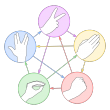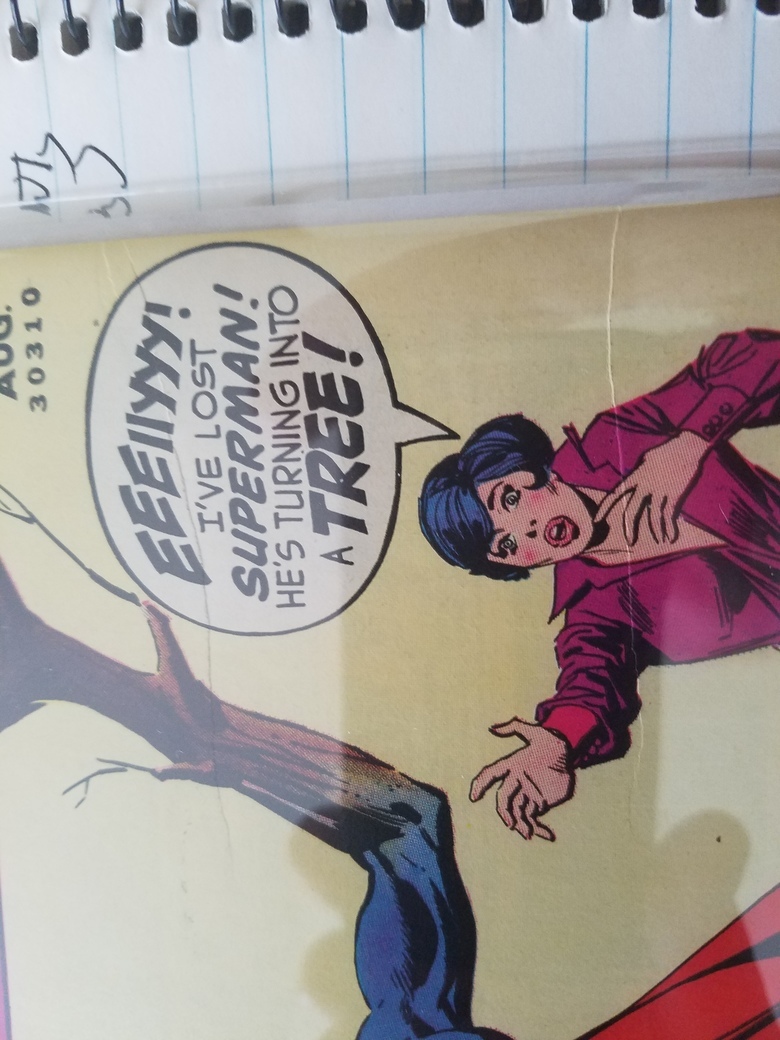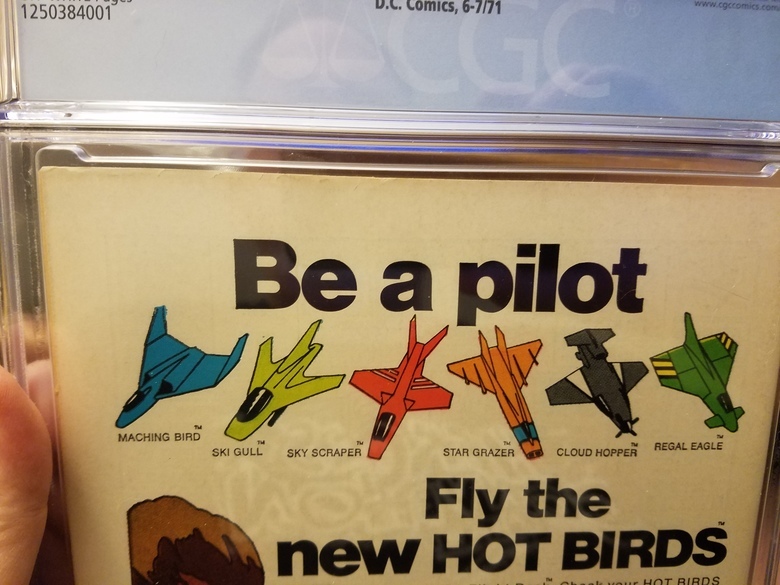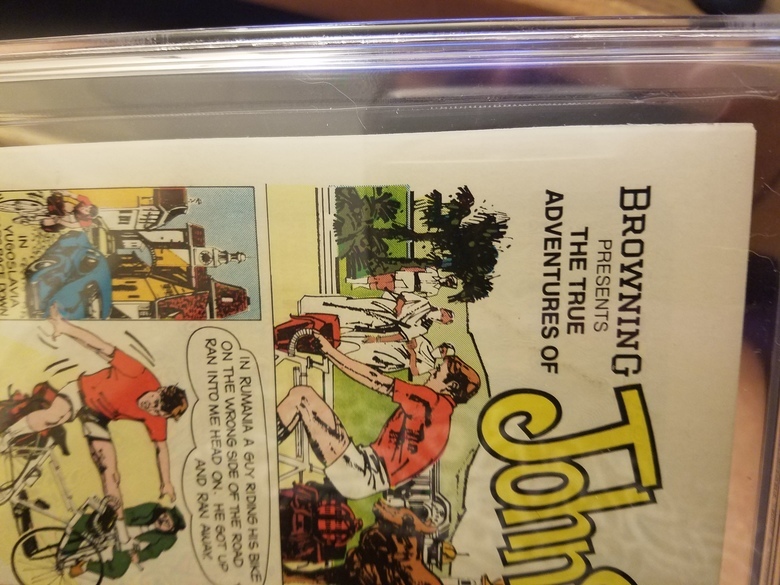Spine Roll7166
 Rock, Paper, Scissors, Lizard, Spock Rock, Paper, Scissors, Lizard, Spock
|
Tedsaid private msg quote post Address this user | |
| I think it is smart to mentally discount a grade with a mis-wrap. But it probably isn't necessary for graders to do so? Anyone can look at the comic and see the miswrap. But of course, it depends on the severity, I'd guess. Grades generally reflect (ideally) how desirable a comic is to the collecting public. And the less even the wrap is, the less collectible the comic. |
||
| Post 26 • IP flag post | ||
 I don't believe this....and I know you don't care that I don't believe this. I don't believe this....and I know you don't care that I don't believe this.
|
GAC private msg quote post Address this user | |
Quote:Originally Posted by SpiderTim Look at the placement of the staples on the comic when looking at mis-wraps vs. spine rolls. Mis-wraps, the staples will be where their supposed to be but the cover is not aligned. A spine roll has all the pages of the book shifted, the spine itself has shifted, placing the staples on top of the book or the bottom of the book. |
||
| Post 27 • IP flag post | ||
 I'm a #2. I'm a #2.
|
BigRedOne1944 private msg quote post Address this user | |
| Good discussion going on here, but Im not exactly sure why it has come this far. I believe it is common knowledge that pretty much any experienced knows the difference between spine roll and a mis-wrapped cover, and the fact that they have absolutely nothing to do with each other. Hopefully the OP has taken note here and become more versed in comic flaws and terminology. |
||
| Post 28 • IP flag post | ||
 I’m not sure they know they’re taking one for the team. I’m not sure they know they’re taking one for the team.
|
Drogio private msg quote post Address this user | |
| I've had comics which only had a production crease cited in the graders notes come back 9.0s and 9.2s. Of course those were cbcs graded. Cgc might have let it go... My point is that not all production defects get a pass. |
||
| Post 29 • IP flag post | ||
 I don't believe this....and I know you don't care that I don't believe this. I don't believe this....and I know you don't care that I don't believe this.
|
GAC private msg quote post Address this user | |
Quote:Originally Posted by Drogio what's a production crease? how does a production crease differ from any other type of crease? |
||
| Post 30 • IP flag post | ||
 CBCS Head Grader CBCS Head Grader
|
SteveRicketts private msg quote post Address this user | |
Quote:Originally Posted by Drogio Production creases are noted so someone buying the book is aware that it was production related, not so much that it was a factor in in the grade of the book. A customer can physically see a miswrap and can determine if they want to bid or buy a book based on the wrap. I know there are people who don't buy miswrapped books, or will pay a premium for one that has a perfect wrap. I am one of those. Production creases can not be as easily seen in photos, thus CBCS will note their presence in the grader's notes. Again, there are buyers who don't like them, which is why we note them. |
||
| Post 31 • IP flag post | ||
 I'm a #2. I'm a #2.
|
BigRedOne1944 private msg quote post Address this user | |
Quote:Originally Posted by SteveRicketts A Crease is a crease IMO, it doesn't matter to me how it got there. They should all carry the same weight and be down graded accordingly. |
||
| Post 32 • IP flag post | ||
 Rock, Paper, Scissors, Lizard, Spock Rock, Paper, Scissors, Lizard, Spock
|
Tedsaid private msg quote post Address this user | |
Quote:Originally Posted by GAC I think a production crease - what I've always called a printing or printer's crease - looks like this. (There are actually two in this picture ... the line across Lois and another one across "EEEIIYYY." ) But @SteveRicketts or someone else will have to give a definitive answer. Steve, while you are at it, I have another question you may be able to answer? (Or anyone else, of course.) The Overstreet grading guide says the 9.4 grade allows for "minor feathering that does not distract from the overall beauty" of the comic. But the included glossary doesn't define "feathering." What is it? Is that when a blade is dull and it kind of pulls / tears the edge of the paper, in a diagonal, jagged pattern? Or is it something else?  |
||
| Post 33 • IP flag post | ||
 I don't believe this....and I know you don't care that I don't believe this. I don't believe this....and I know you don't care that I don't believe this.
|
GAC private msg quote post Address this user | |
Quote:Originally Posted by Tedsaid of course!!! I've seen those before...production crease. |
||
| Post 34 • IP flag post | ||
 I live in RI and Rhode Islanders eat chili with beans. I live in RI and Rhode Islanders eat chili with beans.
|
esaravo private msg quote post Address this user | |
| @Tedsaid - I thought the feathering referred to “soft” corners. | ||
| Post 35 • IP flag post | ||
 I’m not sure they know they’re taking one for the team. I’m not sure they know they’re taking one for the team.
|
Drogio private msg quote post Address this user | |
Quote:Originally Posted by SteveRicketts This kinda pisses me off. I've got several books that the ONLY grading notes were "Production Crease" or "General Waviness" yet got 9.4 OR LESS in grades on all of them. Not just cbcs, but cgc as well. I've been told these "should not" affect grades, yet We are also told that any defects that were a key contributor in determining the grade are in the notes. So my conclusion is either these kinds of "defects" DO effect grades....OR I'm getting screwed in the grades when compared to everyone else with the same book. I'm one to just trust the grade The book gets, but when I hear statements like this I feel as if I should be challenging the grade assigned! |
||
| Post 36 • IP flag post | ||
 CBCS Head Grader CBCS Head Grader
|
SteveRicketts private msg quote post Address this user | |
Quote:Originally Posted by Tedsaid That is a production crease. Feathering is the cracking and fraying along the spine as the result of the cover being creased before assembling the comic. More common on newer books, or books with covers on thicker card stock. |
||
| Post 37 • IP flag post | ||
 CBCS Head Grader CBCS Head Grader
|
SteveRicketts private msg quote post Address this user | |
Quote:Originally Posted by Drogio I didn't say production creases don't have an affect on the grade. The size, location, and severity can affect the grade on books in very high (9.6+) grades. All production creases are not created equally. |
||
| Post 38 • IP flag post | ||
 I’m not sure they know they’re taking one for the team. I’m not sure they know they’re taking one for the team.
|
Drogio private msg quote post Address this user | |
Quote:Originally Posted by esaravo I thought it meant where there are minor breaks in color or "fuzziness" running vertically along the spine, basically a crease between the front and back covers. A lot of the ultimate series (fantastic four, spiderman, X-men) have these really bad given the thick glossy stock not holding up well when the front and back covers were put under pressure (like when stacked). |
||
| Post 39 • IP flag post | ||
 Rock, Paper, Scissors, Lizard, Spock Rock, Paper, Scissors, Lizard, Spock
|
Tedsaid private msg quote post Address this user | |
Quote:Originally Posted by Drogio Yes, that is what Steve Ricketts said. Not good terminology, in my opinion, but I'll take it. Now ... what do we call the tiny angled tears and pulling along the cut edge of the cover, due to a dull blade? (I've included a really bad instance, and a not-quite-so-bad instance, for reference.)   |
||
| Post 40 • IP flag post | ||
 CBCS Head Grader CBCS Head Grader
|
SteveRicketts private msg quote post Address this user | |
| @Tedsaid The tiny bends along the edge of conics, most notably ones from the mid '70s, very common on Star Wars #1, are called "bindery stress" and can affect the grade in very high grades depending on severity. The tiny tears, such as on Marvel Comics from the early to mid '60s are called "Marvel Tears" or "Marcel Chipping" when the tiny pieces are actually missing. |
||
| Post 41 • IP flag post | ||
 I don't believe this....and I know you don't care that I don't believe this. I don't believe this....and I know you don't care that I don't believe this.
|
GAC private msg quote post Address this user | |
Quote:Originally Posted by SteveRicketts These names, "Marvel Tears", "Marvel Chipping", I've obviously read before but I find interesting that Marvel is singled out..is this intentional? Did DC comics of the time not have these issues? |
||
| Post 42 • IP flag post | ||
 Rock, Paper, Scissors, Lizard, Spock Rock, Paper, Scissors, Lizard, Spock
|
Tedsaid private msg quote post Address this user | |
Quote:Originally Posted by SteveRicketts Thanks, Steve. FYI, both of these examples are DC comics: Superman #239 (6-7/71) and Superman #302 (8/76). You have to look closely at the first one, the #239, but those are actually small tears, max about 1/16th inch, and about four-five of them. So maybe it wasn't a production issue that caused it, but something else? (A dull blade was my guess.) |
||
| Post 43 • IP flag post | ||
 CBCS Head Grader CBCS Head Grader
|
SteveRicketts private msg quote post Address this user | |
Quote:Originally Posted by GAC It was just an issue with Marvel at that time. There may be a few instances of DCs with them, but 99.9% of them are on Marvel comics. |
||
| Post 44 • IP flag post | ||
This topic is archived. Start new topic?
